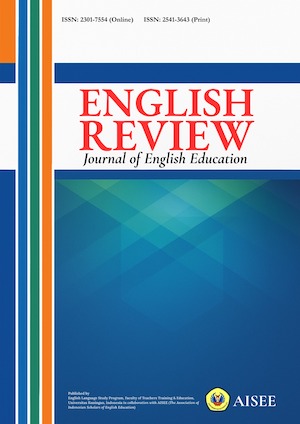METADISCOURSE MARKERS WRITTEN IN INTRODUCTION SECTION OF FINAL PROJECT OF UNIMUS EFL LEARNERS
Abstract
Metadiscourse marker is one of determining indicators of the quality of the writers’ writing. Metadiscourse markers enable the writers to interact with the readers effectively. What commonly happens to many undergraduate students studying English as a foreign language is that they are not able to develop an engagement between themselves, their texts, and their readers. Thus, this study investigates the types of metadiscourse markers used by Unimus EFL learners in final project introduction sections, and markers that are frequently used by them in their writing. By using qualitative and quantitative research method, seven introduction sections of final project of Unimus EFL learners focusing on qualitative and qualitative research methods were chosen purposively. As result, the study revealed that in writing introduction sections, the students used various metadiscourse markers, including interactive resources (transitions, frame markers, endophoric markers, evidentials, and code glosses) and interactional resources (hedges, boosters, attitude markers, engagement markers, and self-mensions). Among those categories, interactive resources were found to be frequently used by the learners rather than interactional resources. It means that the writers tended to give attention to and guided the readers through the text by establishing their interpretations explicitly rather than involving the readers in the argument through the use of markers in interactional dimension.References
Anwardeen, N. H., Luyee, E. O., Gabriel, J. I., & Kalajahi, S. A. R. (2013). An analysis: The usage of metadiscourse in argumentative writing by Malaysian tertiary level of students. English Language Teaching, 6(9), 83-96. doi: 10.5539/elt.v6n9p83.
Cao, F., & Hu, G. (2014). Interactive metadiscourse in research articles: A comparative study of pragmatic and disciplinary influences. Journal of Pragmatics, 66, 15-31. doi: 10.1016/j.pragma.2014.02.007.
Dafouz-Milne, E. (2008). The pragmatic role of textual and interpersonal Metadiscourse markers in the construction and attainment of persuasion: A cross-linguistic study of newspaper discourse. Journal of Pragmatic, 40, 95-113. doi: 0.1016/j.pragma.2007.10.003.
Dehghan, M., & Chalak, A. (2015). Code glosses in academic writing: The comparison of Iranian and native authors. IJRELT, 3(2), 21-29.
Hyland, K. (2010). Metadiscourse: Mapping interactions in academic writing. Nordic Journal of English Studies, 9(2), 125-143.
Hyland, K. (2015). Metadiscourse. The International Encyclopedia of Language and Social Interaction. Retrieved from https://www.researchgate.net/profile/Ken_Hyland/publication/285591598_Metadiscourse/links/59ddf79d0f7e9bec3bae06ad/Metadiscourse.pdf.
Hyland, K., & Tse, P. (2004). Metadiscourse in academic writing: A reappraisal. Applied Linguistics, 25(2), 156-177. doi: 10.1093/applin/25.2.156.
Kuhi, D., & Mojood, M. (2014). Metadiscourse in newspaper genre: a cross-linguistic study of english and Persian editorials. Procedia, Social and Behavioral Sciences, 98, 1046-1055. doi: 10.1016/j.sbspro.2014.03.515.
Rustipa, K. (2014). Metadiscourse in Indonesian EFL learners’ persuasive texts: A case study at English department, UNISBANK. International Journal of English Linguistics, 4(1), 44-52. doi: 10.5539/ijel.v4n1p44.
Suhono, & Haikal. (2018). Interactive metadiscourse and interactional metadiscourse categories of students’ international program school based on gender. IJEE (Indonesian Journal of English Education), 5(1), 81-91. doi: 10.15408/ijee.v5i1.5505.
Wei, J., Li, Y., Zhou, T., & Gong, Z. (2016). Studies on metadiscourse since the 3rd millenium. Journal of Education and Practice, 7(9), 194-204.
Zakaria, M. K., & Malik, F. A. (2017). Metadiscourse in academic writing of pre-university Arab Students at the International Islamic University Malaysia (IIUM). MATEC Web of Conferences. doi:10.1051/matecconf/201815005086.
All articles published in English Review: Journal of English Education (ERJEE) are licensed under the Creative Commons Attribution 4.0 International License (CC BY 4.0).
Copyright Ownership
Authors retain the copyright of their articles and grant ERJEE the right of first publication. The journal is granted a non-exclusive license to publish, reproduce, and distribute the article in any format, medium, or platform, provided that proper credit is given to the original authors.
License Terms – CC BY 4.0
Under the Creative Commons Attribution 4.0 International License, others are free to:
- Share — copy and redistribute the material in any medium or format
- Adapt — remix, transform, and build upon the material for any purpose, even commercially
As long as they:
- Provide appropriate credit to the original author(s) and source
- Provide a link to the license (https://creativecommons.org/licenses/by/4.0/)
- Indicate if any changes were made
There are no restrictions on the reuse, reproduction, or adaptation of published articles as long as attribution is properly given.
Author Warranties
By submitting a manuscript to ERJEE, authors confirm that:
- The work is original and does not infringe any existing copyright.
- The manuscript has not been previously published and is not under consideration elsewhere.
- All sources and references are appropriately acknowledged.
- Necessary permissions have been obtained for any copyrighted materials used.









